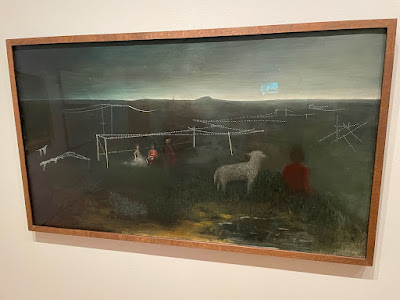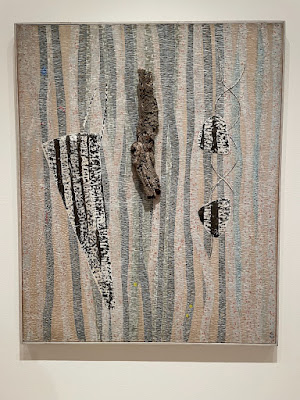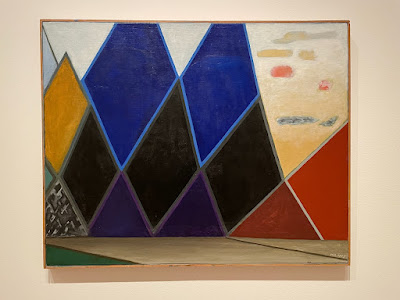Wednesday, November 30, 2022
Strike continues...
Tuesday, November 29, 2022
Halls decked
Strike-torn
Saturday, November 26, 2022
Leave time
Friday, November 25, 2022
Thursday, November 24, 2022
Wednesday, November 23, 2022
Tuesday, November 22, 2022
Geologic
Monday, November 21, 2022
Heading for the hills
 After AAR it's the open road - a mini-holiday in Colorado. But aren't there classes this week? Usually sessions the days before Thanksgiving are so poorly attended everything needs to be repeated after, so I've got in the habit of scheduling things fun but tangential to my courses. This year, the fun tangential things were also going to be online... But as you may have heard, nothing's happening at the moment coursewise: the part-time faculty strike continues, along with solidarity work stoppages from full-time faculty like me. The contract negotiations have apparently been acrimonious and unsatisfying, and it may be a while before agreement is reached. I'll be back at school next week; whether it will be teaching or picketing isn't clear.
After AAR it's the open road - a mini-holiday in Colorado. But aren't there classes this week? Usually sessions the days before Thanksgiving are so poorly attended everything needs to be repeated after, so I've got in the habit of scheduling things fun but tangential to my courses. This year, the fun tangential things were also going to be online... But as you may have heard, nothing's happening at the moment coursewise: the part-time faculty strike continues, along with solidarity work stoppages from full-time faculty like me. The contract negotiations have apparently been acrimonious and unsatisfying, and it may be a while before agreement is reached. I'll be back at school next week; whether it will be teaching or picketing isn't clear.
Sunday, November 20, 2022
AAR cameos
Saturday, November 19, 2022
Present
Gave my first presentation at the American Academy of Religion since 2016. I attended the past two virtually, but it's been years since anything I could imagine presenting on fit the topics in the year's Call for Papers. Even this year was a long shot, for the "Human Enhancement and Transhumanism" unit, who nibbled when I proposed a talk on "Human Enhancement in the Service of 'Making Kin': Donna Haraway's 'Camille Stories' and Posthuman Religious Futures." I thought it was probably because they didn't get many other proposals but it turns out Haraway is an interest of several of them. They even hosted her at the AAR held in San Francisco in 2011! The panel went well, but discussion defaulted to the group's usual concern - humans doing variously human things in service of variously strange human-transcending ideals. The older Haraway of cyborgs was right up their alley, but the new Haraway's suggestion that humans might dissolve the human in service of a broader kinship with animals didn't tempt.
For me it was a fun chance to think about "The Camille Stories," which have figured prominently in all my classes on the anthropocene, whether in connection with religion or humanities, but this time with an audience I knew would "get" religion. But this setting also helped me be more critical of the stories, which seem to me now to be shaped in quite religious - specifically Christian - ways. I'd articulated misgivings about the strange way in which humans in the stories helped themselves to the genes of other species for the syms (who are then fated to lead a life of shamanic service), even as the other species remain untouched. A strangely conservative reticence, coming from a champion of hybridity, but it becomes more troubling still when we learn that many of these species then, despite the best efforts of the syms and the movements they lead, go extinct. The only vestiges of these lost species are the syms themselves! It points toward a future in which nobody is human - but nobody is not human either, a strange return to the anthropocentrism it was trying to escape! And meanwhile, isn't this all disturbingly like a world in which settlers preserve the cultures of indigenous peoples they have driven to extinction?
The discussion helped me see that the Camilles, and indeed all the "syms," are sacrificial offerings to atone for human sins against other species. Nobody chooses to be one, so the syms' experience is more like that of Jesus (in his human form). But there is also a kind of divination going on: the non-human species are given a kind of immortality - surviving their own extinction - through absorption into the syms. All more than a little white savior complex, huh...
The "Human Enhancement and Transhumanism" crew were unfazed by this, being accustomed to encountering these kinds of religious resonances and reenactments in transhumanist projects all the time - and even perhap embracing them.
Friday, November 18, 2022
Vistas

Wednesday, November 16, 2022
WWJBD
 No class today, because the part-time faculty union called its members to strike, starting at 8:30 this morning, and I joined most of the full-time faculty I know in cancelling class in support. The students in my class seemed supportive when we discussed it last week, but didn't show up at the picket line until after the time I was there. I marched in the ever growing loop around the corner entrance to The New School's signature building at midday, enjoying reunions with part- and full-time faculty I hadn't seen in a while, as also my research assistant, hoarse from shouting slogans but transported by the collective energy. Hope they can keep it up as long as they need to! This evening I gather the picket line was enhanced by some canny slogans projected on the face of the building (in our signature font)! I have to smile at this one, since Baldwin was barely here but has become central to our identity; our president is a Baldwin scholar!
No class today, because the part-time faculty union called its members to strike, starting at 8:30 this morning, and I joined most of the full-time faculty I know in cancelling class in support. The students in my class seemed supportive when we discussed it last week, but didn't show up at the picket line until after the time I was there. I marched in the ever growing loop around the corner entrance to The New School's signature building at midday, enjoying reunions with part- and full-time faculty I hadn't seen in a while, as also my research assistant, hoarse from shouting slogans but transported by the collective energy. Hope they can keep it up as long as they need to! This evening I gather the picket line was enhanced by some canny slogans projected on the face of the building (in our signature font)! I have to smile at this one, since Baldwin was barely here but has become central to our identity; our president is a Baldwin scholar!
Tuesday, November 15, 2022
Is the iron hot enough?
Monday, November 14, 2022
Brief reprieve
Sunday, November 13, 2022
No more C
 There was a run on tenors in our church choir today. The professional lead resigned last week, and the promised pinch hitter never arrived. so it was just me, helped out by the bass lead in solo parts. One of our anthems was Elgar's setting of the "Ave verum corpus," but the more fun and demanding was Malcolm Archer's 2002 setting of "And I saw a new heaven" from the always trippy Book of Revelation. Five flats?!
There was a run on tenors in our church choir today. The professional lead resigned last week, and the promised pinch hitter never arrived. so it was just me, helped out by the bass lead in solo parts. One of our anthems was Elgar's setting of the "Ave verum corpus," but the more fun and demanding was Malcolm Archer's 2002 setting of "And I saw a new heaven" from the always trippy Book of Revelation. Five flats?! Saturday, November 12, 2022
Wolken auf einer Brücke
Went to MoMA today and was entranced by the decades-long brilliance of Meret Oppenheim. A non-representative sample:
The Night, Its Volume, and What Endangers It (La Nuit, son volume et ce qui lui est dangereux), 1934
War and Peace (Krieg und Frieden), 1943
Forest Interior with Dryads (Waldinneres mt Dryaden), 1967
Six Clouds on a Bridge (Sechs Wolken auf einer Brücke), 1975
Dark Mountains, Red and Yellow Clouds at Right (Dunkle Berge, rechts gelb-rote Wolken), 1977-79
Friday, November 11, 2022
Goldengrove unleaving
Thursday, November 10, 2022
Wednesday, November 09, 2022
Apocalypse not yet
Midterm election results aren't all in yet, but it seems the worst didn't happen. My fingers remain crossed.
O Tannenbaum
As part of a group presentation on pine trees, a student read us a story on Monday, which started thus:
Those of you that have hiked or driven through the great Ontario Provincial Park that forms most of the Sibley Peninsula and have gazed in wonderment at the magnificent 'White Pines that literally cover the area right up to the Sleeping Giant, may be interested to know that, according to legend, these did not get there by accident. About two thousand years ago, a tribe of Ojibway Indians lived on the shore of Thunder Bay in the vicinity of Sibley Peninsula and had for their Chief a very wise and much traveled Indian, of great birth.
The language of this tale was archaic, and as it went on, it seemed to me more and more suspect. "Two thousand years" was just the first of several clues that this was very particular kind of story. We heard that said venerable chief, on his deathbed, bade his son plant a seed (from a bag he'd filled on distant travels) every time a "papoose" was born, which the son did, raising a forest. Until...
One night, while he lay asleep in his tepee, he was suddenly awakened by a strange sound, his tepee seemed to glow with a bright light and there, at the foot of his bed of furs, stood the Spirits of his father and two other Great Chiefs. The Spirit of Golden Eagle spoke very softly. "My son, you have kept your promise well and we are well pleased. We have come to give you a great duty to perform. Tonight, the greatest Child the world has ever known will be born. Pick the finest seed that you have and go to the highest place and plant it at once. All men will see the tree that springs from it, and wonder…"
If it wasn't obvious by now what was going on, we learned that the seed produced the fastest-growing and tallest tree ever seen, one admired by humans and animals alike, until
This great and magnificent tree lived for thirty years and then one Friday, it was struck down during one of the terrible storms for which Thunder Bay is noted. Now, nothing remains of this beautiful White Pine, but the memory of it is kept alive each year as we place the little gifts for our children under the starlit fragrant bough of our own.















.jpeg)











.jpeg)
















